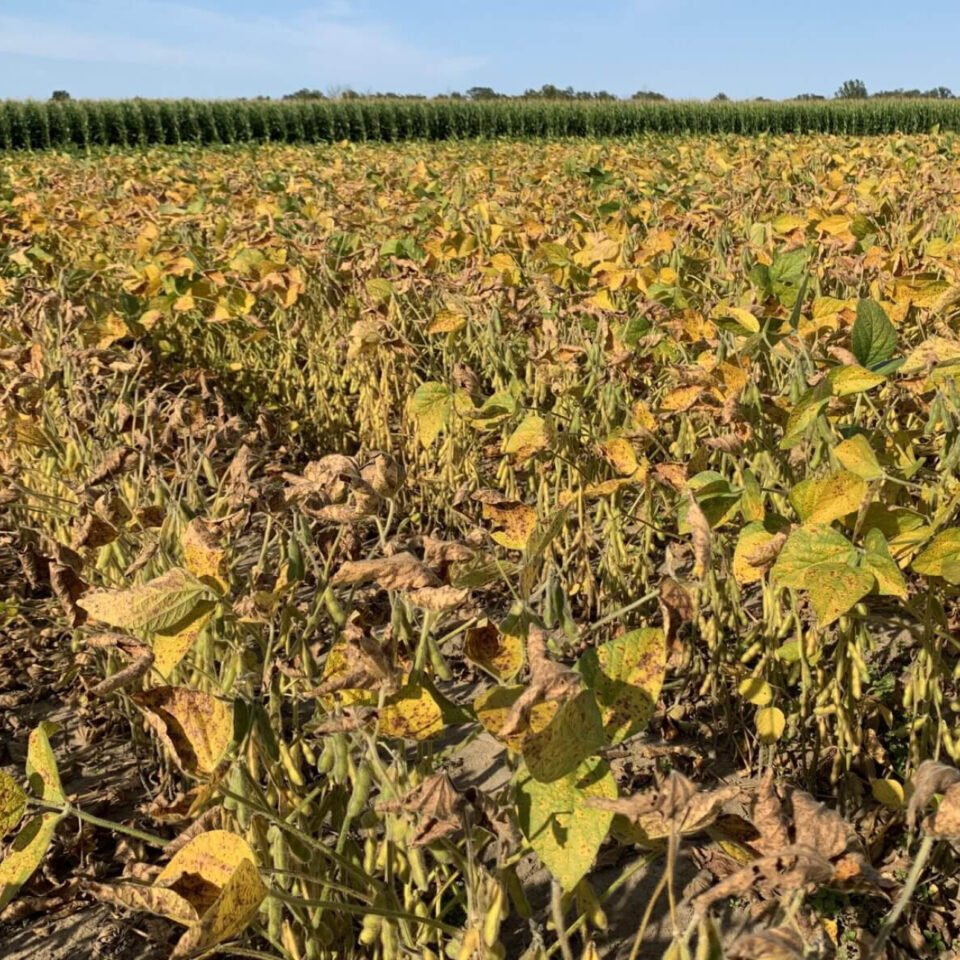
Are Pre-Harvest Burndowns For Me?
As fall rolls along, the soybean crop is in the later reproductive stages and maturation is beginning to occur. At this stage, leaves yellow and fall off, pods will be change colour to brown and ultimately the moisture content will begin a rapid decline in the bean pod. Often for soybeans a pre-harvest burndown (or dessicant) is not necessary. However there are certain fields where weed pressure is strong and also you will find pockets in fields where there is uneven maturity. A desiccant can be used to improve harvestability and evenness in the crop. With the difficulties encountered through the season, many fields have crops at various growth stages, and the thinner areas may have weeds coming up.
Foreign material in soybeans, including weed seed or plant stems will be graded and docked, and can created issues with storage. Certain weeds, like Nightshade or Pokeweed can stain the seed, and create quality issues. IP Soybeans are especially important to keep clean to ensure that you meet grading quality to receive premiums. Depending what soybeans you grow and where they are contracted may impact your choice of desiccants. Always check with your grain merchandiser before applying a pre-harvest burndown. Export markets for soybeans have very strict guidelines on herbicide residues they will accept on the harvested crop and could make the difference between receiving a premium, being downgraded, or even rejected.
Desiccants are used as a harvest aid to help make soybean harvest more efficient. Desiccants will kill and dry down the green tissue on both weeds and the soybean plant. A pre-harvest burndown may be necessary if weed densities are high enough, and can result in:
- Improved soybean seed moisture
- Increased harvest speed
- Less foreign material and damaged seed
You may not need a pre-harvest burndown if:
- The weed size does not interfere with harvest
- The weeds do not have mature seeds that can contaminate the grain
- Dessicant cannot be applied sufficiently ahead of harvest
Important to Remember about Pre-Harvest Burndowns:
Pre-harvest burndowns will not help yield, it will only increase the quality of the harvested seed, and increase efficiency. It is important not to desiccate soybeans just before a rain. Remember to that weeds that are drought stressed will not desiccate effectively. If you apply a desiccant too early it can increase the amount of herbicide getting into the seeds, and increase the MRL (Maximum Residue Level) in the beans potentially making them unacceptable in export markets. You must always follow label restrictions for Pre-Harvest Intervals, and check with your grain merchandiser.
Application Timing:
If the soybeans have hit the R6 stage (where the plant is at full seed and has a pod containing a green seed that fills the pod capacity at one of the four uppermost nodes on the main stem,) this is a good time to begin scouting fields. The R7 growth stage is when there is a pod anywhere that is mature in color (tan or brown) and the plant has leaves that are yellowing. This is the stage where the seed has turned from green to a yellow color. Once the seed turns yellow it separates from the membrane of the pod. Thus seed filling is complete. That is when an application of a desiccant should occur. When scouting, randomly select pods on the top 1/3 of plants to determine if they meet this criteria. If you spray too early, yield and quality are affected. If this stage has occurred then physiological maturing has happened and the soybeans can be sprayed.
Get in touch with your Sylvite Ag Consultant or Sales Rep to ensure your application timing is correct!
Tips for a Successful Pre-Harvest Burndown:
- Pre harvest herbicides do not speed up maturity, or make dry down faster. They only help drop remaining leaves and dry out green material.
- If large patches of the soybeans in the field remain green, you will need to wait for these areas to mature before spraying.
- Be aware of the weed species you are targeting. Perennial and annual weeds may require different strategies to control because of the different ways they absorb and translocate herbicides within their tissue.
- Do not spray too early. Marketing problems can occur if sprayed too early.
Application Tips:
The challenge with spray is to get it through the crop canopy. Below are some ways to help:
- Evaluate where you are directing your spray into the canopy to do the best job possible. You need to direct the desiccant to where the green stems and leaves are.
- Having a bird’s eye view of your canopy is a good way to go. If your weeds are mixed in with a lot of foliage then you may need to use more water, slower speeds, or finer sprays to be able to get into the canopy.
- Applying spray to plant parts that you can’t see can be a difficult challenge. In order to get around the obstructions and to get more spray on the petioles and stems, you may have to increase the spray pressure of your low-drift nozzles.
- By slowing down, adding water, and pointing nozzles backward, you will get more spray deeper into canopy.
- Some desiccants work better in the heat of the day for rapid burning, some work better applied in the evening to allow for more translocation.
- Plan ahead and make sure you give yourself enough time between spraying and harvest.
Tips on spraying pre-harvest and desiccation sprays came from the guys at Sprayers101.
Featured Image: Real Agriculture